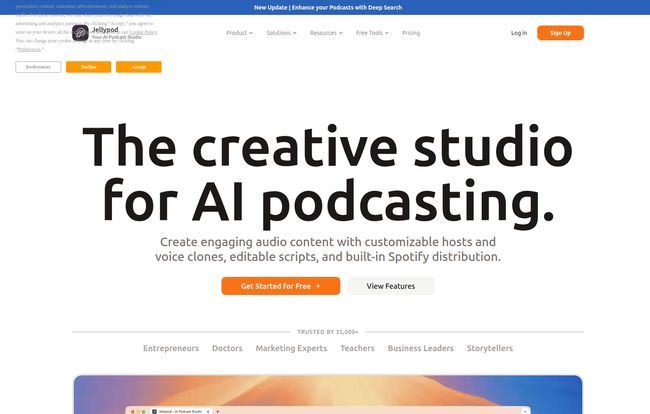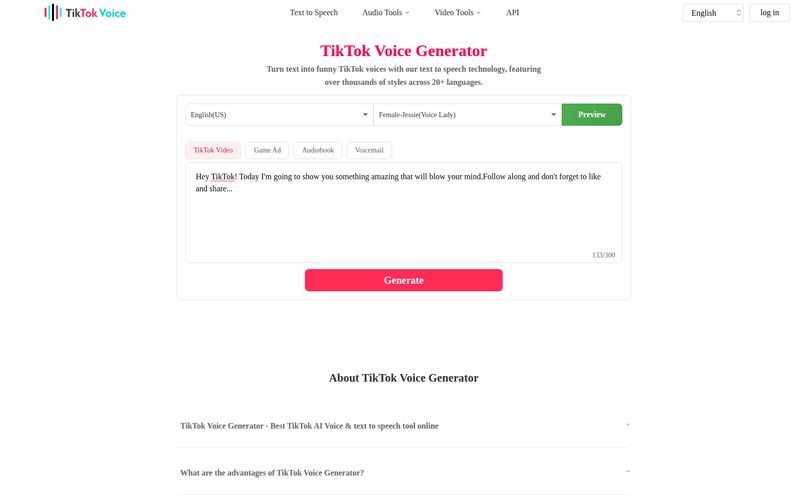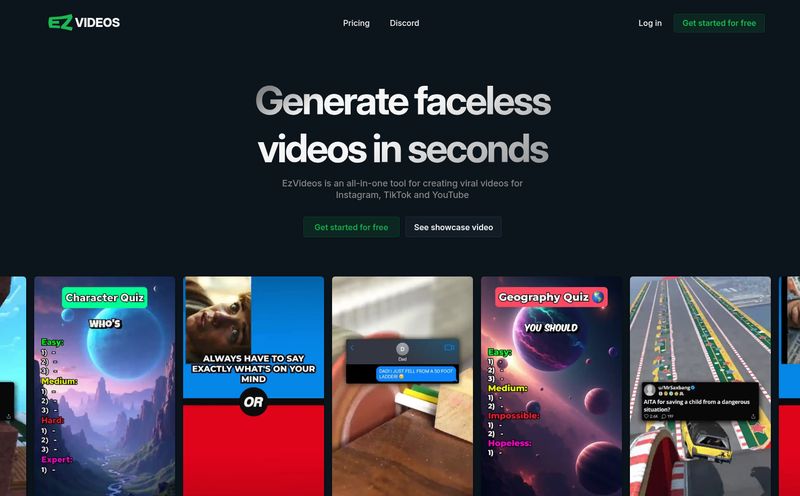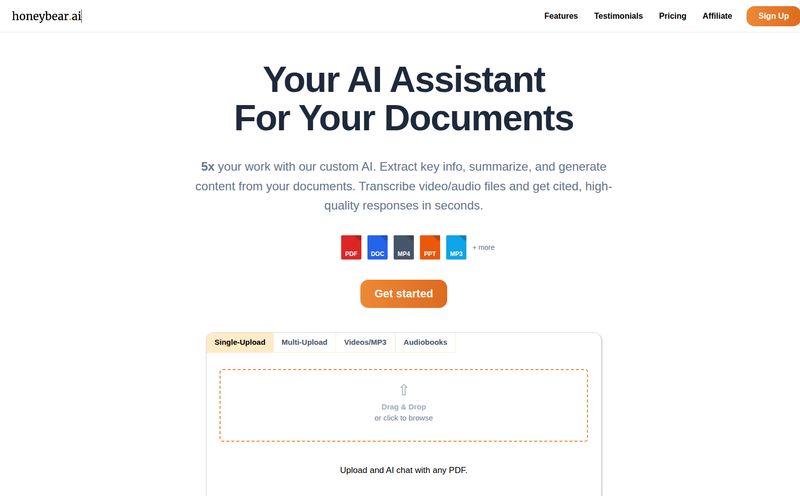I tried to start a podcast about three years ago. I had the concept, the passion, and what I thought was a decent USB microphone. I recorded three episodes. Do you know how many I published? Zero. The sheer amount of work—the editing, the awkward pauses, the ums and ahs, mixing in intro music, writing show notes—it just crushed me. My little podcast dream died a quiet death on a dusty external hard drive.
It’s a story I hear all the time from fellow marketers and creators. The barrier to entry for podcasting isn't the idea; it's the execution. It’s a massive time suck.
So, when I started seeing tools like Jellypod pop up, claiming to be a “creative studio for AI podcasting,” my inner, defeated podcaster sat up and listened. An AI that writes the script, creates the audio with customizable hosts, and even publishes it for you? It sounds a bit like science fiction. Or at least like something that would produce soulless, robotic content. But I’m a professional tinkerer, so I had to take a look. Is this thing just hype, or could it genuinely be the answer for busy people who have something to say but no time to say it?
So, What is Jellypod, Really?
Let's get straight to it. Jellypod is an AI-powered platform designed to automate almost the entire podcast creation process. Think of it less as a simple tool and more like a miniature, automated production team that lives in your web browser. You act as the producer, giving it the raw materials and the creative direction, and it handles the grunt work.
You feed it a source—like a blog post URL, a research paper PDF, or even just a general topic to search the web for. Then, you tell it what kind of podcast you want, complete with custom AI hosts, and it generates a full-fledged audio episode. It writes a conversational script, records it with surprisingly realistic AI voices, and can even push it out to major platforms like Spotify and Apple Podcasts. It's built for people who are experts in their field—doctors, business leaders, marketers—but not necessarily in audio engineering.

Visit Jellypod
The whole idea is to take your existing knowledge or content and transform it into a new format, opening up your message to a whole new audience that prefers listening over reading. And let’s be real, in our content-saturated world, repurposing isn't just a strategy; it's a survival tactic.
Breaking Down the Jellypod Features
Okay, the high-level concept is cool. But as we all know, the devil is in the details. A tool can have a great sales page, but does it actually work? Here’s what stood out to me as I poked around inside Jellypod.
The AI Hosts Are More Than Just Robots
My biggest fear with AI audio was that it would sound like the automated voice on the train. You know the one. Lifeless. But Jellypod does something interesting. It lets you design your hosts. You don’t just pick a voice; you can create a persona, give them a backstory, and choose from a library of voices. This adds a layer of personality that I wasn't expecting. You can have a solo host, or a duo that has a back-and-forth conversation. It’s a clever way to make the final product feel more like a real show and less like a document being read aloud. It’s not perfect, but it’s miles ahead of basic text-to-speech.
Your Content, Repurposed into Audio Gold
For me, as an SEO and content person, this is the absolute core of Jellypod's appeal. The ability to drop in a URL to one of my existing blog posts and have it turned into a podcast episode is... well, it's huge. All that work you put into a 2,000-word article can suddenly have a second life, reaching people while they're at the gym, commuting, or doing the dishes.
It doesn't just stop at URLs. You can upload PDFs, text files, or have it perform a “Deep Search” on a topic. It pulls information, synthesizes it, and builds a script. It even supports multilingual content translation, which is a massive opportunity for anyone trying to build a global audience. Imagine turning your English content into a Spanish or German podcast with minimal effort. That’s a serious growth lever.
From Script to Spotify with a Few Clicks
This is where my past podcasting trauma really gets soothed. Jellypod automates the entire distribution pipeline. Once the episode is generated, you can have it pushed directly to platforms like Spotify, Apple Podcasts, and YouTube. It creates the RSS feed for you, which is one of those small technical hurdles that trips up a lot of beginners. No more fiddling with XML files or logging into a separate hosting provider. It’s all integrated. It also generates audiograms—those little videos with a waveform and subtitles—which are perfect for promoting your new episode on Instagram or LinkedIn. They’ve clearly thought about the full marketing lifecycle, not just the creation part.
Let's Talk Money: The Jellypod Pricing Tiers
Alright, this all sounds great, but what’s the damage? AI tools can get pricey, and it's always a question of value. Jellypod uses a credit-based system and has a few different tiers. Here's my quick breakdown:
| Plan | Monthly Price | Key Features | Best For |
|---|---|---|---|
| Free | $0 | 1000 generation credits (one-time), 1 AI Host, Unlimited Shows. | Testing the waters and seeing if the workflow fits your style. |
| Starter | $24 | 2500 monthly credits, 2 hosts/voice clones, distribution to major platforms. | Solo creators and small businesses just starting their audio journey. |
| Creator | $47 | 8000 monthly credits, 4 hosts/voice clones, remove Jellypod branding. | Serious content creators and marketers who need more volume and a professional look. |
| Business | $150 | 24,000 monthly credits, 8 hosts/voice clones, priority support. | Agencies or larger businesses managing multiple shows or a high-volume content strategy. |
Note: Prices and features are based on information available at the time of writing and may change. Always check the official Jellypod pricing page for the latest details.
My take? The Free plan is genuinely useful for a trial run. The Starter plan is a solid entry point. But I think the Creator plan is the sweet spot for most professionals. Removing the Jellypod branding is critical for building your own brand identity, and the 8000 monthly credits give you plenty of room to produce regular content. The AI voice cloning, which lets you create a digital version of your own voice, also starts to become more accessible at the paid tiers, which is a powerful feature for personal brands.
The Good, The Bad, and The AI
No tool is perfect. Let’s be real about where Jellypod shines and where you might feel some friction.
On the plus side, the speed and efficiency are undeniable. The ability to go from a simple idea or a piece of text to a fully produced podcast in minutes is something that would have sounded like a wild fantasy a few years ago. The content repurposing angle is a massive win for any content-driven business. It lowers the barrier to entry for audio so much that it's almost nonexistent.
However, there are trade-offs. The main one is a potential loss of creative spontaneity. The charm of many podcasts comes from the unscripted banter, the off-the-cuff remarks, and the genuine human interaction. While Jellypod’s AI is good at creating a conversational script, it's still a script. You won't capture those magic, unplanned moments. Futhermore, you're placing a lot of trust in the AI's ability to accurately interpret your source material and write a compelling script. For highly technical or sensitive topics, you'd still want to give that script a very thorough human review.
Final Thoughts: Is Jellypod Worth It?
After spending some time with it, I'm genuinely impressed. Jellypod isn't for the podcasting purist who loves the art of audio editing and the craft of a long-form interview. And that’s okay.
But for the person I was three years ago—the busy professional with ideas to share but no time for the production nightmare—it’s a revelation. It's for the marketing team that needs to scale its content output. It's for the consultant who wants to turn their whitepapers into an engaging audio series. It's a tool of leverage, plain and simple.
I don't think AI will replace the top-tier, personality-driven podcasts we all love. But for the vast world of informational and brand-driven content, tools like Jellypod are going to become standard. It's about augmenting our abilities, not replacing our creativity. It finally makes podcasting accessible to everyone, not just those with time and technical skills. And maybe, just maybe, it's time to go find that old hard drive.
Frequently Asked Questions about Jellypod
- How does the AI actually generate a podcast script?
- Jellypod's AI analyzes the source content you provide (like a URL or PDF). It identifies the main points, structures them into a conversational flow, and then writes a script as if two hosts were discussing the topic. You can then edit and refine this script before generating the audio.
- Can I really use my own voice in the podcast?
- Yes, on the paid plans. Jellypod offers an AI Voice Cloning feature. You provide a sample of your voice, and the platform creates a digital replica that can then read any script you generate. This is great for maintaining a personal touch and brand consistency.
- Where exactly does Jellypod publish the podcasts to?
- The platform facilitates one-click distribution to major podcast directories, including Spotify, Apple Podcasts, and Google Podcasts. It also helps you publish to YouTube, which is a huge bonus for discoverability.
- Is the Free plan actually useful or just a teaser?
- It's quite useful for a trial. The 1000 one-time credits are enough to generate a few short test episodes to see if you like the quality of the AI voices and scripts. You won't be able to run a full show on it long-term, but it's a perfect, no-risk way to evaluate the platform.
- What are the 'Generation Credits' and how do they work?
- Credits are the currency you use within Jellypod. Different actions, like generating a script or creating audio, consume a certain number of credits. The more complex or lengthy the task, the more credits it uses. Paid plans come with a monthly allotment of these credits.
- How realistic do the AI voices sound?
- They are surprisingly realistic and among the better AI voices I've heard. They have good intonation and pacing. While you can still tell they're AI if you listen closely, they are far from the monotone robotic voices of the past and are perfectly suitable for informational content.
Reference and Sources
- Jellypod Official Website
- Jellypod Official Pricing Page
- Spotify for Podcasters
- Forbes Article on Generative AI in the Creator Economy



